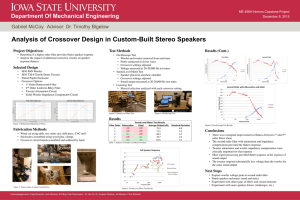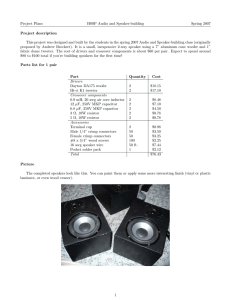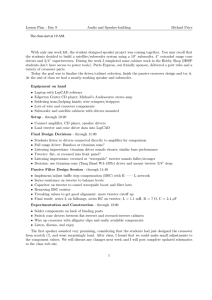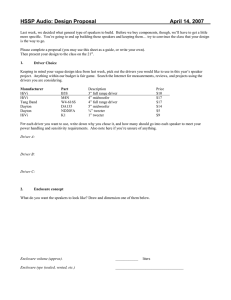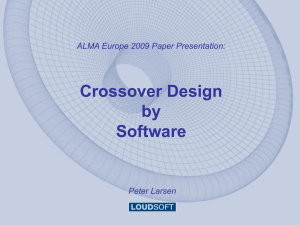Loudspeaker Design: A Tribute to Bud Fried
advertisement
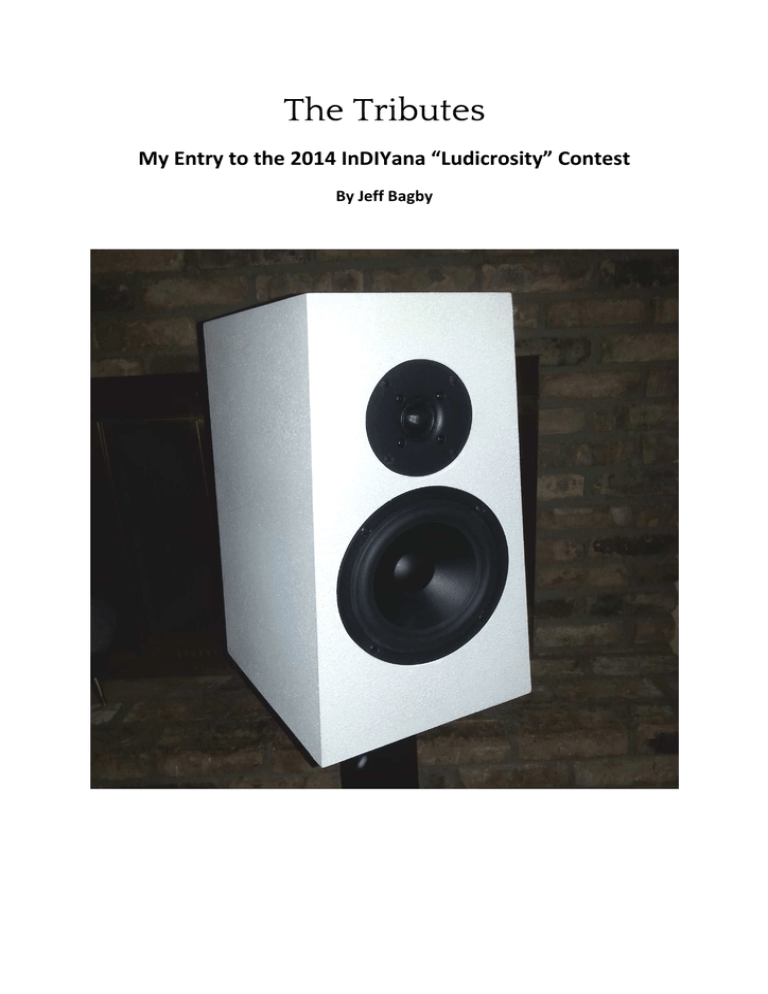
The Tributes My Entry to the 2014 InDIYana “Ludicrosity” Contest By Jeff Bagby Introduction The basic idea behind the Ludicrosity contest was to make a speaker that was a bit different from what is normally produced. Cabinets were to be non-rectilinear, and crossover something other than the typical even order in-phase type, with special points for using a series crossover. I decided to give it a try for fun, and if I was going to do it, I might as well take it seriously and try to design a truly well-thought-out design. Although it wasn’t exactly the plan at the beginning, as the design evolved I decided to build a speaker as a tribute to Bud Fried, inspired by his C3 Monitor from the 1970’s. Irving M. (Bud) Fried (pronounced: “Freed”) was the founder of IMF speakers in the 70’s, a company that focused on transmission line enclosures and the use of series type crossovers. Later Bud reformed his company as “Fried Loudspeakers”, and developed what became a very highly regarded two-way monitor (the “C” series) that used a 6.5” poly cone woofer, a dome tweeter, and was housed in a trapezoidal enclosure employing a quasi-transmission line loading. Bud was considered one of the great pioneers of the golden age of stereo, born in 1920, Bud passed from this world in 2005. A man of his stature deserves a “Tribute” and this loudspeaker design entry is my tribute to his legacy. The Crossover Concept Anyone familiar with Bud Fried as a designer will know that any speaker inspired by his legacy must incorporate a series crossover. This is one area where no other options exist. In designing this speaker I set a fairly lofty goal for myself. I wanted to see if it were possible to create a successful design using what I call a “balanced Series Crossover”. In my “balanced Series Crossover” the second order filter values for both the highpass and lowpass sections are identical mirror images of each other, and the padding resistor used on the tweeter will also be used to balance the impedance between both sides of the crossover, making this possible. Obviously, such a crossover is theoretically possible, but there is no guarantee that it will work from a practical standpoint. The key here will be the selection of the drivers. The Drivers Keeping with the spirit of the C series Fried speakers I chose a 6.5” poly cone woofer from SB Acoustics, model SB17MFC35. This is a very nice cast frame midwoofer with shorting rings to lower distortion, a rubber surround, and an attractive black poly cone. In the Fried C series, Bud used Tweeters beginning with the Dynaudio D28 (horn loaded), then the Scanspeak D2010, and finally the Hiquphon dome tweeter, designed by Oskar Wroending for use in Fried speakers. I chose an SB tweeter, a 1” (26mm) silk dome unit, model SB26STAC. This is a very nice silk dome with cast faceplate, ceramic magnet, and dual shorting rings in the motor. It has very linear response and very low nonlinear distortion. These drivers were mounted in a small trapezoidal shape cabinet of .5 cu ft (14 liter) with a rear loaded port and small baffle that tapers toward the top. Here is the raw frequency response of both the woofer and the tweeter when mounted on this baffle: As you can see, there is a very broad overlap in the response of these two drivers drivers, which makes them ideal for this application. The Crossover Design Now to the crossover design itself – in the world ld of series crossover,( where the drivers are in series with each other, and the crossover components are in series with each other, then the component are in parallel to the driver) we have what is a called a “QSO” or Quasi Quasi-Second Second Order crossover. In this thi type, by changing the ratio of the capacitor to the inductor (Zeta ratio) you can arrive at a crossover that initially rolls-off off second order but later levels out to first order (or less in the case of the tweeter). This type of filter can put a great deal al of stress on the tweeter, tweeter, reducing its power handling and increasing distortion and harshness in it presentation presentation. My idea was to reverse this: Use a second order circuit that by manipulating the ratio of the components resulted in a filter that initial initially rolled-off off first order and transitioned to second order beyond the crossover point. By attempting to keep the crossover balanced (see above) I was able to achieve something quite interesting. By targeting initial shallow roll-offs roll offs I could incorporate some so level of baffle step compensation into the woofer’s filter while still rolling the tweeter off gradually (first order) as well. This resulted in an asymmetrical acoustic filter with a second order Bessel response on the woofer and first order Butterworth th on the tweeter. The transfer function of the filter when loaded with each driver’s complex impedance is presented here: When these transfer functions are applied to the measured driver responses the Passive Crossover Designer prediction of the acoustic acoustic crossover and summed response look like this: A simulation of the acoustic crossover response is about the best we can do, because it is nearly impossible to measure individual driver responses using series crossovers because of the way each driver is dependent on the other. According to the simulation we will have an asymmetrical crossover comprised of a second order Bessel response on the woofer and a first order Butterworth response on the tweeter that combines to a very flat summed response when the driver offsets are accounted for. Here is the schematic for my balance series crossover: .80 mH Air Core + 10 uf Poly SB Acoustics SB17MFC35-08 Poly Cone Midwoofer .80 mH Air Core SB Acoustics SB26STAC Silk Dome Tweeter + 10 uf Poly 3 Ohm - Bass Loading and System Impedance Although this woofer will work very well in a sealed box and yield nice, extended bass, I started off making it a vented system with 2” diameter port 8” long. This tunes the enclosure to 38 Hz. Here is the system impedance of the speaker as a classic vented system: However, as I stated above the original Fried C3 was a type of transmission line system. I call this a quasi-transmission transmission line because in reality the size of the enclosure and the dimensions of the port reveal the C3 to be a classic vented speaker speaker but with heavy damping. With this in mind I began to add damping to the enclosure in the form of pulled Dacron batting. I even experimented with damping material inside the port, but the end I only used a filled enclosure and left the port free of any damping material. The following graph shows the effect of this fill on the system impedance: As you can see from the blue line above above,, the box fill has almost eliminated the lower impedance peak associated with the port. This is common in damped transmission transmission line enclosures enclosures, and although the lower impedance peak is almost nonexistent there is still significant output coming from the port. So, in the spirit of the original Fried C3, we also have a small damped quasi-transmission line enclosure. One final comment about the system impedance - this speaker presents a nice stable load with a nominal impedance of 8 ohms and a minimum impedance of 6.9 ohms. System Frequency Response Measurements Measuring on the optimum axis, which is just below the tweeter to optimize the time relationship between the two drivers, the following is the actual measured frequency and measured phase response using 1/48th octave smoothing and using 100 Hz for a low frequency cut-off: Not only does the predicted summed response in PCD prove to be correct, but the use of a the Second Order Bessel lowpass and First Order Butterworth highpass combines to produce linear phase response. With frequency and phase response the Tribute meets the requirements of a Quasi-Transient Perfect design as well. This is a very difficult combination to achieve, but has worked out nicely in the Tribute design. Jeff Bagby
